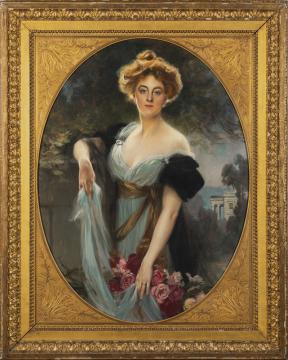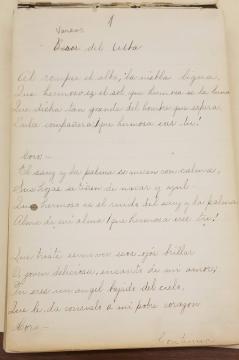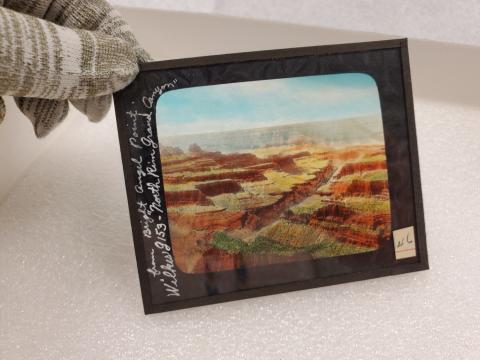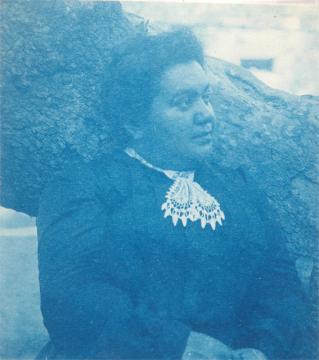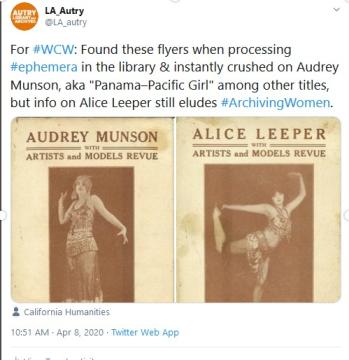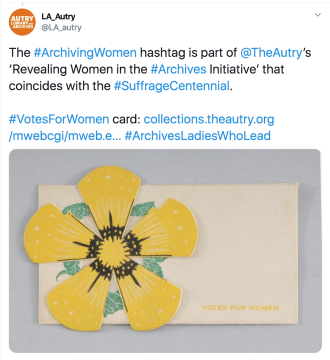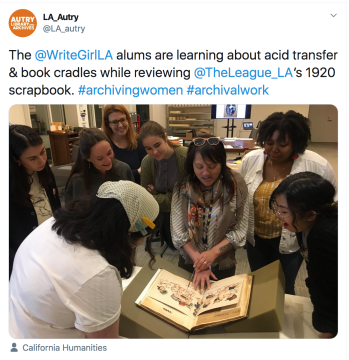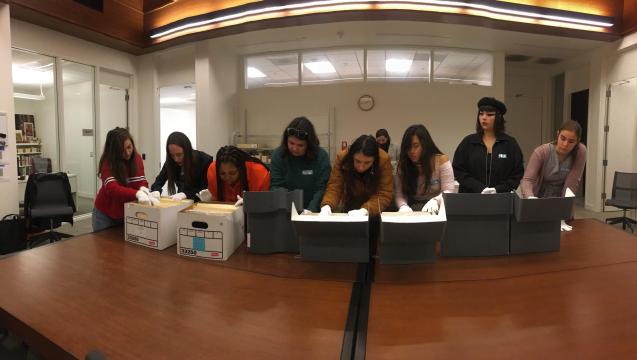By: Victoria Bernal, Women in the Archives Social Media Manager and Liza Posas, Head of Research Services and Archives
In January, the Autry embarked on a year-long Revealing Women in the Archives initiative that celebrates the 2020 centennial of women winning the vote by facilitating the discovery of women’s historical contributions. Through programming, a workshop series, a social media campaign and the exhibition, What’s Her Story: Women in the Archives, this initiative is designed to engage the public in physical as well as virtual spaces.
The Autry’s Library and Archives launched the project in January by co-hosting a "Discovery Fellow” workshop with WriteGirl, a Los Angeles-based creative writing and mentoring organization for young women. Held at the Autry’s Resources Center, the first two workshops (out of three) introduced the WriteGirl participants to archive work and the role it plays in recording women’s stories. The hands-on workshop encouraged participants to physically and intellectually interact with the woman-focused archives and to develop their own reflections about women’s stories from the past. These young women explored Autry collections such as the scrapbooks from the Assistance League of Los Angeles Institutional Archives, the wax cylinder recordings of Manuela Garcia, and the diaries of Caroline Boeing Pool. Participants also learned the basic principles of archival processing as well as how to create more inclusive narratives posited by archivists such as Dominique Luster, the Charles “Teenie” Harris Archivist at the Carnegie Museum of Art.
Although the last of the workshop series has been postponed due to shelter-in-place, the virtual aspect of the initiative has only grown. Using the hashtag #ArchivingWomen, the Autry’s Library and Archives shares the women’s stories revealed through the Autry’s online collection as well as through the work of archival processing-- whether in the midst of digitization, re-housing, reference work, cataloging, or one of the many activities related to making these stories “discoverable.” Posts throughout 2020 will capture moments in the archives that focus on unpacking of archive boxes, but also the unpacking of women’s lives.
#ArchivingWomen social media content can be found on Twitter, Instagram, Tumblr and the Autry blog. The Autry has begun developing city- wide partnerships with librarians and archivists to contribute social media content that helps de-mystifiy archives and promote awareness of archives for everyone. Social media is a powerful tool to generate awareness of the values of archives, the gems filed away in archival folders & boxes, and the importance of preserving women’s legacies.
Drawing attention to archival work is another goal for Revealing Women in the Archive. Little attention is often given to the first step in representing the accomplishments of women in history–caring for the primary source material, cataloging the materials and documenting their stories through a finding aid. This lack of awareness of archival work can lead to big headlines that some historic item was “discovered” in the archives. As Harvard curator John Overholt explained in a 2012 article in The Atlantic, "It's important to remember that in most cases what's termed an archival 'discovery' was possible only because of the years or decades of effort a repository invested in arranging, describing, preserving, and providing access to the materials in its care.”
Revealing Women in the Archives initiative further considers how women’s archives are a response to the question of what women have done and how they do it. It also seeks to empower a shared discovery of women's voices and explores how attention paid to women’s archives change how we view history and ourselves.
This project was made possible with support from California Humanities, a non-profit partner of the National Endowment for the Humanities. Visit calhum.org.

